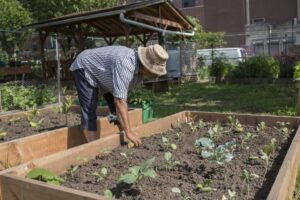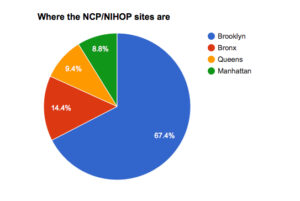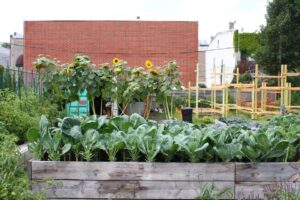 Ena McPherson working at Brooklyn’s Tranquility Farm / Photo: Andrew Caringi
Ena McPherson working at Brooklyn’s Tranquility Farm / Photo: Andrew Caringi
Ena McPherson always noticed the catalpa tree when she walked by the vacant lot on the corner of Throop Avenue. Despite barren surroundings, and nearby boxes of rat poison, the tree still grew. When she gained access to the lot in 2011, volunteers hauled out truckloads of debris—including the metal roll-up gate from an old jerk chicken restaurant—and slowly brought the land back to life.
Today, Tranquility Farm—named after the farm McPherson’s grandfather ran in Jamaica—is a green oasis. The catalpa has been joined by a bee colony, fruit trees, vegetable beds, an herb garden, a lush lawn, many types of exotic flora, a rainwater catchment system and a student-built gazebo.
“The spirit of gardening really is to make something out of nothing,” says McPherson. “We put our blood, sweat and tears into developing these sites that nobody wanted.”
Yet unlike the three other sites that McPherson manages in the neighborhood, Tranquility Farm is on land owned by the New York City Department of Housing Preservation and Development (HPD) under a temporary license agreement. Now the city wants it back.
Tranquility Farm is just one of about 180 other small city-owned sites identified by HPD for potential development under two new affordable housing construction programs. Out of these sites, 18 currently have community gardens on them and 10 of those gardens are in Bedford-Stuyvesant, Weeksville or Brownsville. Some people see the gardens’ inclusion on this list as a mistake. Others see it as an inevitable result of the area’s difficult past.
Land scarce for de Blasio plan
These sites—victims of arson, redlining and other forms of neglect—came into the city’s possession through tax foreclosure, starting in the 1970s. By 1978 the city-owned 32,000 lots and has been trying to sell them off ever since. Most of the remaining large parcels were sold for development during the Bloomberg administration. The ones that are left—smaller and harder to develop—are now being used as part of Mayor de Blasio’s plan to build 80,000 units of affordable housing in 10 years.
HPD has created two new programs to squeeze every possible unit onto these small lots. The New Infill Homeownership Opportunities Program (NIHOP) will focus on creating small multi-family homes and condominium or co-op buildings. The Neighborhood Construction Program (NCP) will create apartment buildings with up to 30 rental units. Due to the challenge of building on these sites, the city is offering them to developers for $1.

“The smaller the development, the harder it is to make work as affordable housing,” says Moses Gates, director of planning and community development at the Association for Neighborhood and Housing Development.
Gates says that rather than just focusing on overall construction goals at all costs, the city must factor in the needs of local communities.
“The city’s perspective is every unit of housing they build is necessary, because with more people coming into the city you need more housing period,” he says. “We’re really focused on you don’t just build housing, you have to build the right kind of housing.”
While buildings with units for low-income tenants often need a certain percentage of market rate units to be sustainable over time, the de Blasio administration hasn’t set any specific criteria about how to strike this balance in NCP and NIHOP projects. Non-profit developers and community development corporations were encouraged to apply for the programs, the idea being that they would strive to have the units be as affordable as possible, but it can be hard to make the math work. The land is cheap, but the architects, lawyers, insurance, financing, equipment, labor and materials will still cost the same as usual.

“A building costs just as much to build in East New York as in Chelsea,” says Erica Sims, deputy executive director at Mutual Housing Association of New York (MHANY), which has been developing small buildings in Brooklyn for nearly 30 years.
At the same time, federal affordable housing subsidies are pegged to income levels that bear little relation to what families in Bedford-Stuyvesant and surrounding neighborhoods actually make. According to HPD’s term sheets, rental units in NCP buildings will be available for people making up to 165 percent of Area Median Income, or AMI. For NIHOP homeowner units, one-third are required to be affordable. In that case, “affordable” is defined as a maximum of 80 percent AMI. If developers choose to take advantage of the U.S. Department of Housing and Urban Development’s Low-Income Housing Tax Credit Program, the maximum will be 60 percent of AMI.
New York’s AMI covers all five boroughs—plus Westchester, Putnam and Rockland Counties. The 2015 AMI for HUD’s New York City region is $60,500 for an individual and $86,300 for a family of four. These numbers are far higher than local incomes in Central Brooklyn. According to the 2013 American Community Survey—the most recent data available—the median household income was $27,166 in Brownsville, $36,535 in Bedford-Stuyvesant and $41,144 in northern Crown Heights.
Even if local residents can afford the rents at the new developments, they’ll face tough competition to get into them. The city’s housing lottery system requires that 50 percent of affordable units in new buildings must be reserved for residents from the local community district. But demand often exceeds that amount.
The case for gardens
The number of units that will be created under the NIHOP and NCP programs may be small compared to the city’s ambitious housing plans, but the fate of the land they’ll use could have lasting effects. With so many issues involving the construction, accessibility and value of the housing in these programs, some advocates believe that gardens may be of greater value to the communities than new buildings in some cases.
Eddie Bautista, executive director of the New York City Environmental Justice Alliance, says gardens and open spaces should be recognized for the roles they play in climate change resiliency. A recent report highlighted Central Brooklyn as one of the areas most vulnerable to extreme heat waves in coming decades. In addition to heat-related deaths, crime levels could also be exacerbated by rising temperatures.
“This stuff has all kinds of ramifications,” says Bautista. “There’s a bunch of resiliency measures that I don’t believe community gardens and open space have gotten proper credit for.”
While residents can’t control what happens on local private lots—which seem to be sprouting new construction projects by the day—they can share their input on what happens on city-owned land.
Paula Segal, executive director of 596 Acres, works to open up land access opportunities on unused city property. She says the inclusion of the 18 gardens on HPD’s list of potential sites must be rethought and that the city still has many other vacant lots available. HPD has developed housing on land controlled by other city agencies in the past.
“These are not tokens in a deal-making game. These are properties that were acquired by the city for some form of public purpose and improving neighborhoods,” she says. “This is a fire sale.”
Segal has been working with community members and other garden groups to get the 18 sites removed from HPD’s list. So far the city hasn’t made a decision. The deadline for developers to submit their applications to qualify for NCP and NIHOP projects was in February. Once developers are selected, HPD will then match them up with sites.
HPD did not reply to requests for further information about how sites were chosen or when developers would be selected.
The struggle between housing and open space has always been a part of the community garden movement in New York. Operation Green Thumb was launched in 1978 to make vacant lots available for gardens on an interim basis, as a way to help struggling neighborhoods. While empty lots often attracted garbage and crime, gardens maintained by community members revitalized their blocks. During the 1980s, the city had more than 1,000 active gardens.
Though many have been supplanted by development over the years, and Mayor Giuliani later attempted to take most of these plots back for construction, the city’s garden network is still strong. The Green Thumb program currently includes more than 600 active gardens. About half of these gardens operate under ongoing license agreements with the Department of Parks & Recreation (DPR). Others are privately owned, or part of public land trusts. The rest are on city sites—including 46 on HPD land—with the understanding that they could eventually be asked to leave or relocate, as is happening now.
“Our partnership with HPD to create interim gardens is incredibly successful and we will do our best to help our gardeners thrive in these spaces in their communities,” said DPR press officer Tara Kiernan in a statement. “We have time and opportunity ahead of us to find workable outcomes.”
The gardeners speak
Despite the possibility of having to leave their gardens, residents have turned many sites into flourishing agricultural and community hubs that hearken back to Brooklyn’s past. In the 1880s, Brooklyn was one of the largest vegetable producers in the country. The output is much lower today, but the positive effect on local communities is growing.
In Brownsville, where good produce can be hard to find at stores and healthy restaurant options are scarce, locally grown fruits and vegetables are even more important.

“It’s like an infestation with fast food restaurants in this area,” says Brenda Thompson-Duchene, who manages five gardens in the neighborhood. Three of these gardens are on the HPD site list.
Inspired by her childhood garden in Aruba, Thompson-Duchene has made it her full-time job to grow and educate as much as possible. Her newest site, the Brownsville Student Farm, is meant specifically for children from local schools and court-mandated community service programs to come get their hands dirty.
Though a recent termite infestation set them back, she plans to grow cucumbers, spinach, kale, eggplant, asparagus, tomatoes and much more. A new chicken coop will eventually be occupied as well and the children will sell their harvest for a discounted rate at their own farmstand. Thompson-Duchene says that eating locally-grown produce can help with endemic health problems such as hypertension, diabetes and obesity.
Thompson-Duchene recognizes the need for affordable housing in Brownsville, where the spread of real estate development and speculation has slowly begun, but says it can’t overtake community spaces.
“Why can’t we coexist?” she asks. “We need both.”
A 2008 study from NYU’s Furman Center—co-authored by current HPD Commissioner Vicki Been—actually found that community gardens help increase property values in the surrounding area.
The members of 462 Halsey Community Garden in Bedford-Stuyvesant are feeling this pressure even more imminently. Located near the corner of Lewis Avenue, where new shops and restaurants have begun to open in recent years, and housing prices are on the rise, the garden is meant to be a place for new and old residents to come together.
“We’re not just a vegetable garden where everyone’s growing things privately,” says Alice Forbes Spear, a local resident who helps manage the garden.
Communal beds comprise the majority of 462 Halsey’s verdant space, along with a compost operation that processes approximately 1,000 pounds of food scraps per month. Along with newer residents, the garden also has members who have lived in the neighborhood for decades.
Anita Baxter, a 50-year resident, says the garden takes her back to growing up in Jamaica and has helped lower her blood pressure. Like the rest of her fellow members, she is concerned about the city potentially shutting them down.
“I hope they don’t, because it will be a big loss to all of us,” she says.
Interest rising
With Central Brooklyn’s popularity on the rise, housing in the area is more sought after than ever. Greg Todd, a real estate broker who manages the Imani II Garden in Weeksville—also on HPD’s list—says he has noticed a change in people’s perceptions of the area within the last couple years. He recalls one building that he had trouble selling units in for years which recently saw a shift.
“At first they were coming and saying, ‘Crown Heights, that’s a bad neighborhood.’ And now it’s, ‘Oh, Crown Heights, that’s a hot neighborhood,’” Todd says of prospective buyers.
Following similar actions in Harlem and Bushwick, Brooklyn’s Community Board 8 recently approved a letter of support for the Imani II Garden in Weeksville and many local elected officials have also chimed in.
Council Member Robert Cornegy, Jr.—whose district includes five of the gardens on HPD’s list—supports the gardeners, but also seems to recognize the odds they’re up against.
“The community gardeners and their neighbors have been amazing in this fight. Our shared goal is to divert the development to other city-owned lots in the district and save the gardens,” he said in an emailed statement. “If the gardens must be lost, I hope the gardeners will continue to stand with me in insisting that the affordable homeownership options be truly affordable to residents of Central Brooklyn.”
Until a decision comes down from HPD, gardeners will continue to enjoy what might be one of the last summers in their spaces.
With the cost of living on the rise, and New York’s population projected to reach upwards of 9 million people by 2040, it’s undeniable that affordable housing is needed. Yet green communal spaces are also crucial to the future viability of Brooklyn’s neighborhoods.
At Bedford-Stuyvesant’s Patchen Community Square, now in its third year, local kids come to play on the lawn while their parents plant bok choy and blueberries. Kyiehsa Kelly, who lives nearby with her family, says that before the garden opened she could barely keep a houseplant alive. Now, she’s teaching her daughters how to grow vegetables.
“I think seeing the flowers makes people really happy, seeing something that’s beautiful besides another building,” she says. “I can’t see anybody coming in here and wanting to destroy this.”
Produced in collaboration with City Limits.
